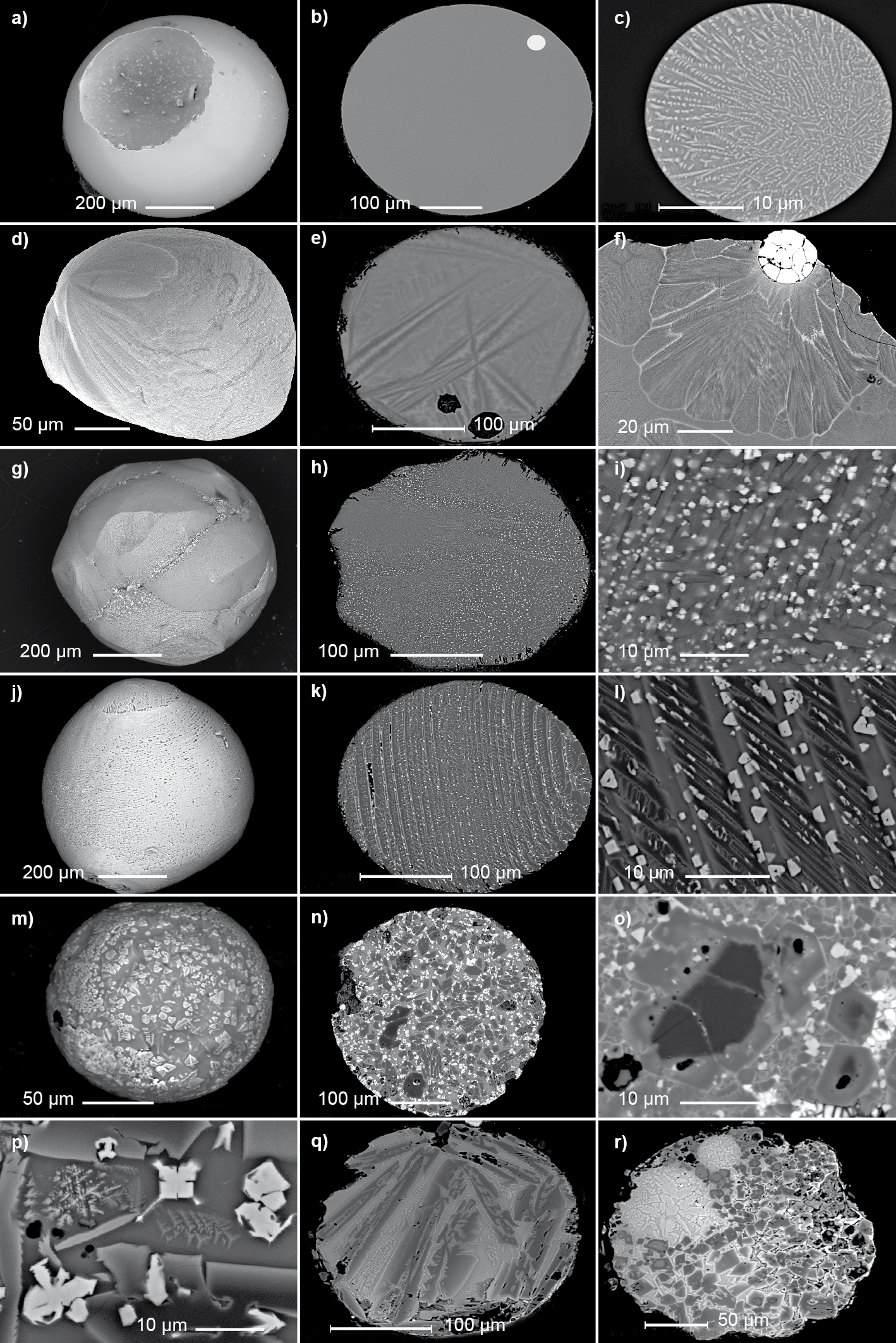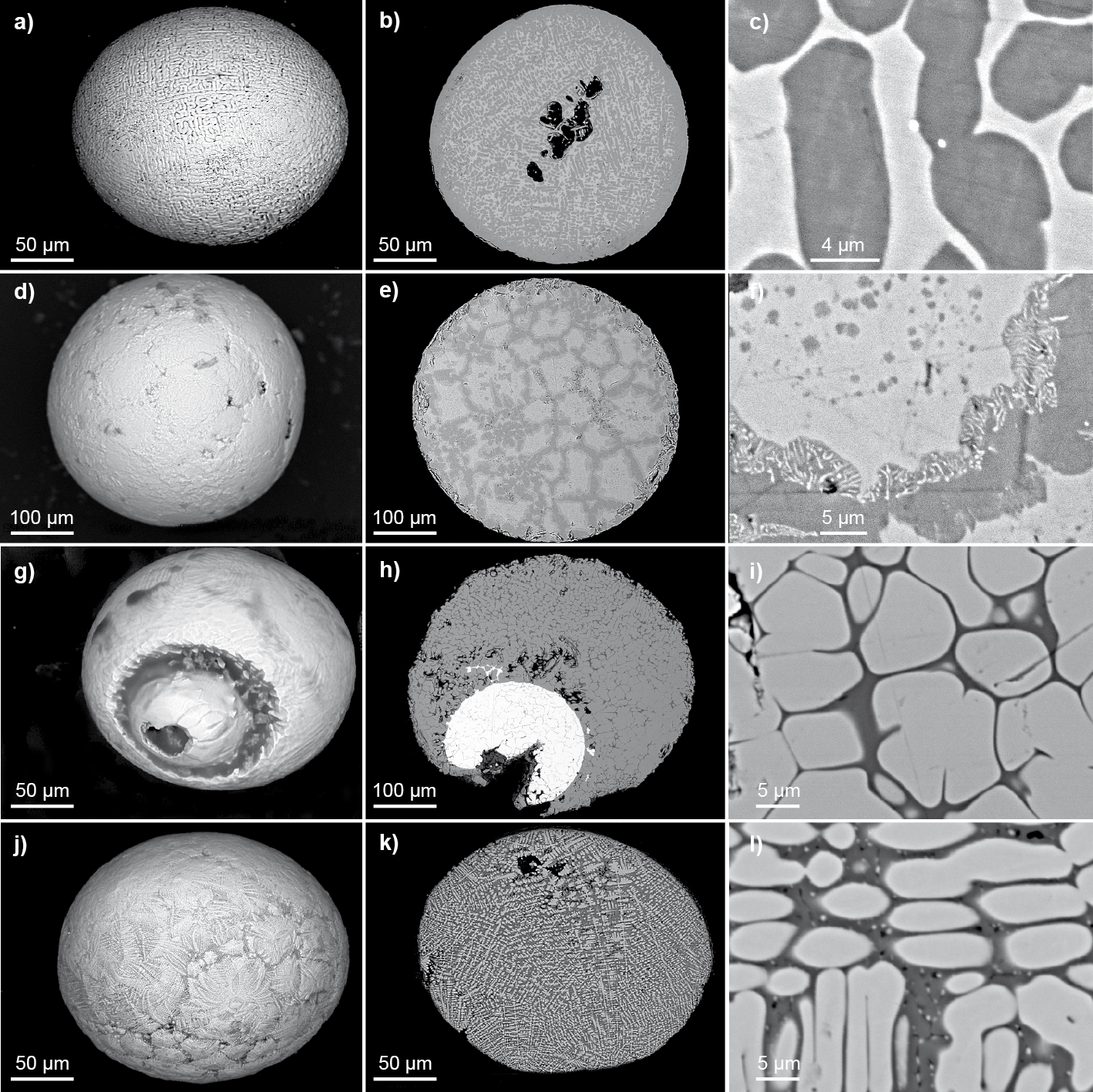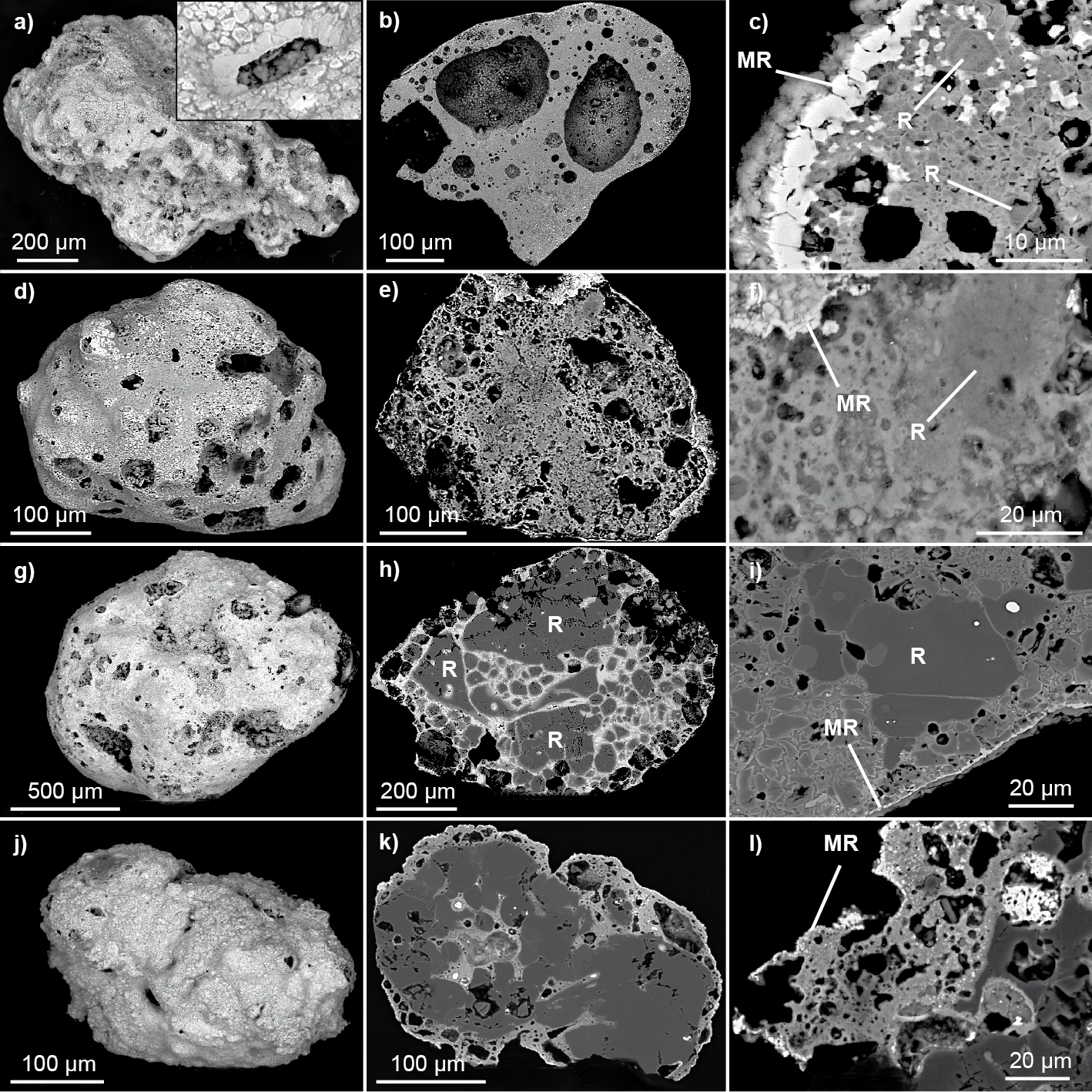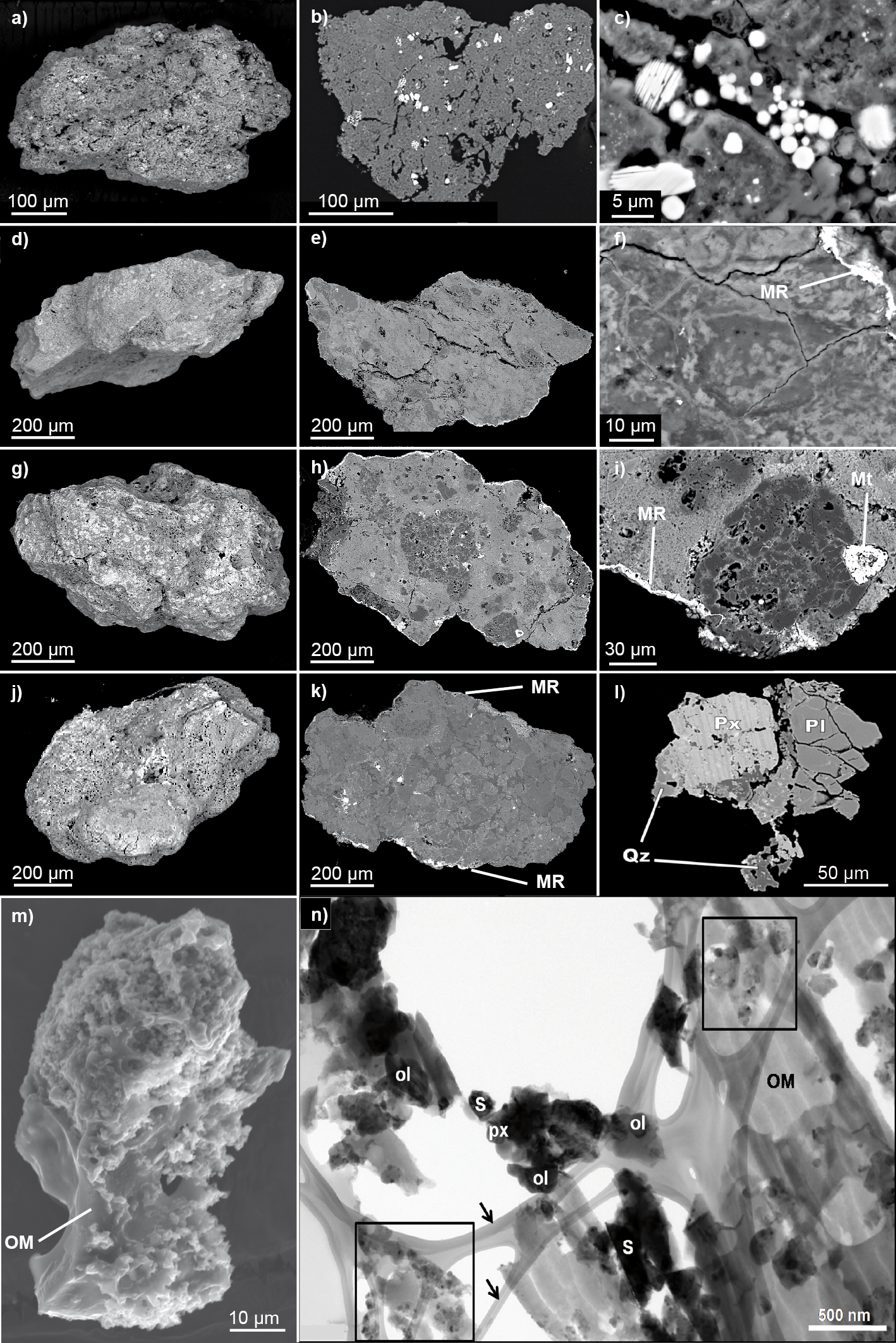Stereomicroscopic images of various classes of micrometeorites. (a – f ) Glass cosmic spherules showing the most common range of colours and variable vesicularity. (g) Crypto- crystalline cosmic spherule with characteristic turtle-back (polyhedral-like) morphology. (h–i) Barred olivine cosmic spherules showing characteristic striations. ( j) CAT cosmic spherule with its characteristic milky white colour. (k) Porphyritic cosmic spherule. (l) I-type cosmic spherule with its characteristic metallic lustre. (m) G-type cosmic spherule. (n) Partially melted micrometeorite with characteristic scoriaceous structure. (o – p) Unmelted micrometeorites with characteristic angular to sub-angular shapes. Scale bars = 150 µm. All micrometeorites are from the Transantarctic Mountain collection.

Copyright © 1997 - 2018 Mineralogical Society of America.
Back-scattered electron images of silicate cosmic spherules. (a) Glass cosmic spherule (hollow structure). (b) Section of a glass cosmic spherule showing homogeneous glass composition and an Fe–Ni– S metal bleb (white). (c) Detail of the Fe–Ni–S metal bleb featured in part b showing dendritic quench texture. (d) Cryptocrystalline cosmic spherule showing feather-like texture in relief. (e) A section of a crypto- crystalline spherule. ( f ) A detail of a sectioned cryptocrystalline spherule showing a Ni-rich Fe, Ni metal bleb at one margin (white). (g) Cryptocrystalline cosmic spherule with characteristic turtle-back (polyhedral-like) morphology. (h) A section of the same spherule. (i) Textural details of the same sectioned spherule showing olivine (grey) and magnetite crystallites (white) in glass (dark grey). ( j) Barred olivine cosmic spherules showing characteristic striations. (k) A section of the same spherule. (l) Textural detail of the same spherule showing Mg-rich olivine bars (dark grey) and magnetite crystallites (white) in Fe-rich glass (grey). (m) Porphyritic cosmic spherule showing subhedral magnetite microphenocrysts decorating the external surface. (n–r) Sections of porphyritic cosmic spherules showing a range of textures. They consist mainly of olivine microphenocrysts (dark grey) in glass (grey) plus magnetite (white). Note the dark grey Mg-rich olivine relicts (indicating that the particle did not totally melt during atmospheric entry) overgrown by paler more Fe-rich olivine microphenocrysts in (n), (o) and (r). The micrometeorite in ( f ) is from the South Pole Water Well collection (courtesy of S. Taylor); all others are from the Transantarctic Mountain collection.

Copyright © 1997 - 2018 Mineralogical Society of America.
Back-scattered electron images of I-type (a–i) and G-type ( j–l) cosmic spherules. (a) Equigranular I-type cosmic spherule. (b) I-type spherule in section showing interlocking magnetite (dark grey) and wu ̈stite (pale grey). Note the magnetite shell at the spherule surface due to increasing oxidation and the void at centre due to rapid solidification which started from the spherule surface. (c) A detail of the same spherule featuring interlocking magnetite (dark grey) and wu ̈stite (pale grey) with platinum-group element nuggets (white dots). (d) I-type spherule with web structure. (e) A section of the same spherule showing that the web structure con- sists of bright wu ̈stite domains (pale grey) surrounded by magnetite (dark grey). ( f ) A textural detail of the web structure showing fine intergrowths at the contact between wu ̈stite (pale grey) and magnetite (dark grey). (g) A button-shaped I-type cosmic spherule. The protuberance is a Ni-rich Fe,Ni metal bleb. (h) A section of an I-type cosmic spherule dominated by wu ̈stite (grey) with an eccentric Ni-rich Fe,Ni metal bleb (white). (i) A detail of the same spherule showing wu ̈stite grains (pale gray) with minor interstitial silicate glass (dark grey). ( j) G-type cosmic spherule consisting of bright magnetite dendrites in dark silicate glass. (k) The texture of the same spherule in section. (l) A textural detail of the same spherule showing fine magnetite dendrites in glass. All micrometeorites are from the Transantarctic Mountain collection.

Copyright © 1997 - 2018 Mineralogical Society of America.
Back-scattered electron images of partially melted or scoriaceous micrometeorites. (a) An irregularly shaped yet rounded scoriaceous micrometeorite with a magnetite envelope; inset: a detail of the magnetite envelope close to a vesicle (diameter: 30 mm) opening through the external surface. (b–c) Polished section of the same micrometeorite revealing its fine-grained texture consisting of microphenocrysts of olivine embedded in highly vesicular glass. Note the olivine relict cores (R) and the magnetite rim (MR) in (c). (d–f ) Another example of fine-grained scoriaceous micrometeorite. Note the fine vesicularity of the glass in (f) and decomposed relicts (R). (g–h) A coarse-grained scoriaceous micrometeorite, with abundant coarse-grained olivine and enstatite relicts (R). (i) Detail of a similar micrometeorite with abundant relict grains (R). (j–l) Another example of coarse-grained scoriaceous micrometeorite dominated by coarse- grained olivine and enstatite crystals arranged in two rounded aggregates interpreted as chondrule relicts (van Ginneken et al., 2012). The latter are surrounded by a scoriaceous igneous rim (detailed in part l) as a result of atmospheric melting. All micrometeorites are from the Transantarctic Mountain collection.

Copyright © 1997 - 2018 Mineralogical Society of America.
Back-scattered electron (a–l), secondary electron (m) and bright-field TEM (n) images of unmelted micrometeorites. (a) A fine-grained unmelted micrometeorite consisting of porous silicate material speckled with magnetite framboids and plaquettes similar to CI-chondrite. Dehydration cracks are visible throughout. (b) A section of the same micrometeorite. (c) Close-up view of magnetite framboids and plaquettes in dehydration cracks. The fine-grained silicate matrix is devoid of textural evidence for phyllosilicates indicating thermal alteration. (d ) An angular unmelted micrometeorite with a complete magnetite envelope. (e) A section of the same micrometeorite showing a compact fine-grained texture with significant spatial variation in the Fe/Mg ratio (dark versus pale areas) similar to CM chondrite matrix. ( f ) A detail of the same micrometeorite close to the surface enveloped of magnetite (MR). (g) Another unmelted micrometeorite with a complete mag- netite envelope. (h) A section of the same micrometeorite revealing its CV chondrite composition. (i) Detail of a magnetite (Mt) bearing porphyritic olivine-pyroxene chondrule of the same micrometeorite. Note the magnetite envelope (MR). ( j) A third example of unmelted micrometeorite enveloped in a magnetite shell. (k) A section of the same micrometeorite revealing its equilibrated ordinary chondrite composition. The magnetite rim is indicated (MR). (l) A section of a differentiated particle consisting of exsolved pyroxene (Px), plagioclase (Pl), and quartz (Qz). (m) A fine-grained ultracarbonacous micrometeorite with abundant organic matter (OM). (n) Another ultracarbonaceous micrometeorite mounted on a C-film (black arrows) for Transmission Electron Microscope (TEM) observations. The crystalline phases are forsterite (ol), enstatite (px), Fe-Ni sulfides (S), associated with organic matter (OM). Regions with abundant GEMS are delimited in black. Micrometeorites featured in (a) to (k) are from the Transantarctic Mountain collection, that featured in (l) is from Cape Prudhomme, Terra Ade ́lie, Antarctica (courtesy of M. Gounelle), and those in (m) and (n) are from the CONCORDIA collection (courtesy of J. Duprat).

Copyright © 1997 - 2018 Mineralogical Society of America.
All photographs appearing in the Gallery are the exclusive property of Mineralogical Society of America and published in: Folco L, Cordier C (2015) Micrometeorites. In European Mineralogical Union Notes in Planetary Mineralogy, 15:253-297. DOI: 10.1180/EMU-notes 15.9.
